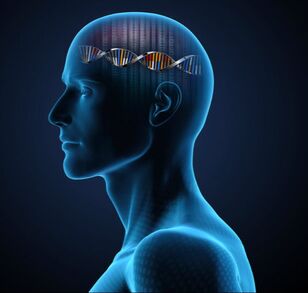|
DNA Nourishment of the Brain
By William J. Walsh, PhD, FACN Each person has about 25 trillion cells that contain identical DNA molecules that determine eye color, gender, and other inborn characteristics. However, DNA also acts as a workhorse that continuously provides special proteins that nourish the body’s brain neurons, glia, and other cells in the body. Although microscopic in appearance, each DNA is made up of about six billion “nucleotide” sub-molecules in a double-helix array. |
If all if a person’s DNA molecules were stretched out and attached end-to-end, the total length would equal 400 times the distance to the sun. It’s not surprising that an enormous amount of information is contained in a DNA molecule. Each DNA has about 21,000 coding genes that contain a “blueprint” for making proteins. Every gene has a single job – to enable production of a specific protein that might be an enzyme, ion channel, transcription factor, or other important molecule. Special molecules called “messenger RNA” or “mRNA” copy the gene’s chemical code and bring it to the cell’s protein-production area. Depending on the gene, an expressed protein may be quite small and linear, or composed of more than 500 amino acids in a complex shape. Most expressed proteins are far from perfect and contain mutations called SNPs (single nucleotide polymorphisms) in which a single amino acid is out of place.
Most SNPs have little or no effect on a protein’s function, but others can cause considerable mischief. For example, a 677t SNP mutation in the MTHRF gene can reduce enzymatic activity by about two-thirds and cause a methylation disorder. In another example, APOE gene mutations in which cysteine residues are replaced by arginine residues result in APOE-3 or APOE-4 and a higher likelihood of Alzheimers Disease. About 10 million SNP mutations are present in each person’s DNA, which suggests we all could be considered mutants. Our specific SNP mutations help define our personality, abilities, and vulnerability to diseases. Examples of expressed proteins that powerfully impact mental health include (a) ion channels (b) enzymes that enable synthesis of neurotransmitters, and (c) SERT transporter proteins that control serotonin reuptake. Many birth defects and mental illnesses are caused by SNP mutations that alter the structure and functioning of genetically-expressed proteins.
Each cell line and tissue needs a different combination of expressed proteins and this is partially accomplished by in-utero placement of methylation “bookmarks” on DNA that regulate gene expression. If DNA locations near a gene are methylated, the production of the associated protein will be inhibited. During the nine months in the womb, protein expression rates for each tissue are “fine-tuned” by cell-specific transcription factors, miRNA, and other molecules. This is how a proper menu of expressed nutrients can be delivered to each cell. In a healthy cell, necessary proteins are supplied at the proper rate and unwanted proteins are avoided.
Child development during the nine months of gestation is an extraordinary and complex process. For example, there are more than 2,000 potential transcription-factors, 1,600 miRNA molecules, and 68 histone genes that might or might-not be active in a specific cell line. This amazing process enables a person’s 25 trillion identical DNAs to nourish each cell with an ideal and diverse combination of expressed proteins.
Most SNPs have little or no effect on a protein’s function, but others can cause considerable mischief. For example, a 677t SNP mutation in the MTHRF gene can reduce enzymatic activity by about two-thirds and cause a methylation disorder. In another example, APOE gene mutations in which cysteine residues are replaced by arginine residues result in APOE-3 or APOE-4 and a higher likelihood of Alzheimers Disease. About 10 million SNP mutations are present in each person’s DNA, which suggests we all could be considered mutants. Our specific SNP mutations help define our personality, abilities, and vulnerability to diseases. Examples of expressed proteins that powerfully impact mental health include (a) ion channels (b) enzymes that enable synthesis of neurotransmitters, and (c) SERT transporter proteins that control serotonin reuptake. Many birth defects and mental illnesses are caused by SNP mutations that alter the structure and functioning of genetically-expressed proteins.
Each cell line and tissue needs a different combination of expressed proteins and this is partially accomplished by in-utero placement of methylation “bookmarks” on DNA that regulate gene expression. If DNA locations near a gene are methylated, the production of the associated protein will be inhibited. During the nine months in the womb, protein expression rates for each tissue are “fine-tuned” by cell-specific transcription factors, miRNA, and other molecules. This is how a proper menu of expressed nutrients can be delivered to each cell. In a healthy cell, necessary proteins are supplied at the proper rate and unwanted proteins are avoided.
Child development during the nine months of gestation is an extraordinary and complex process. For example, there are more than 2,000 potential transcription-factors, 1,600 miRNA molecules, and 68 histone genes that might or might-not be active in a specific cell line. This amazing process enables a person’s 25 trillion identical DNAs to nourish each cell with an ideal and diverse combination of expressed proteins.

